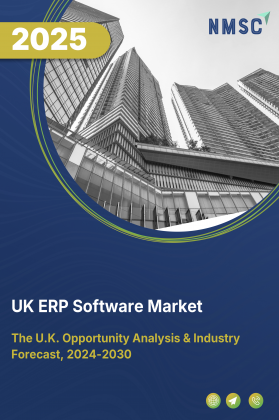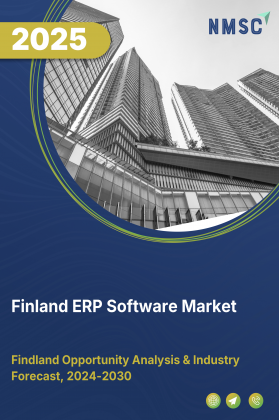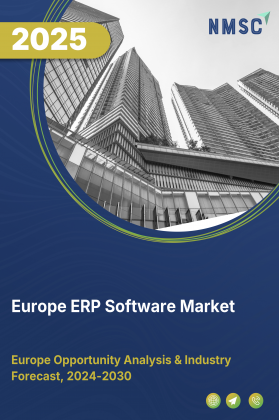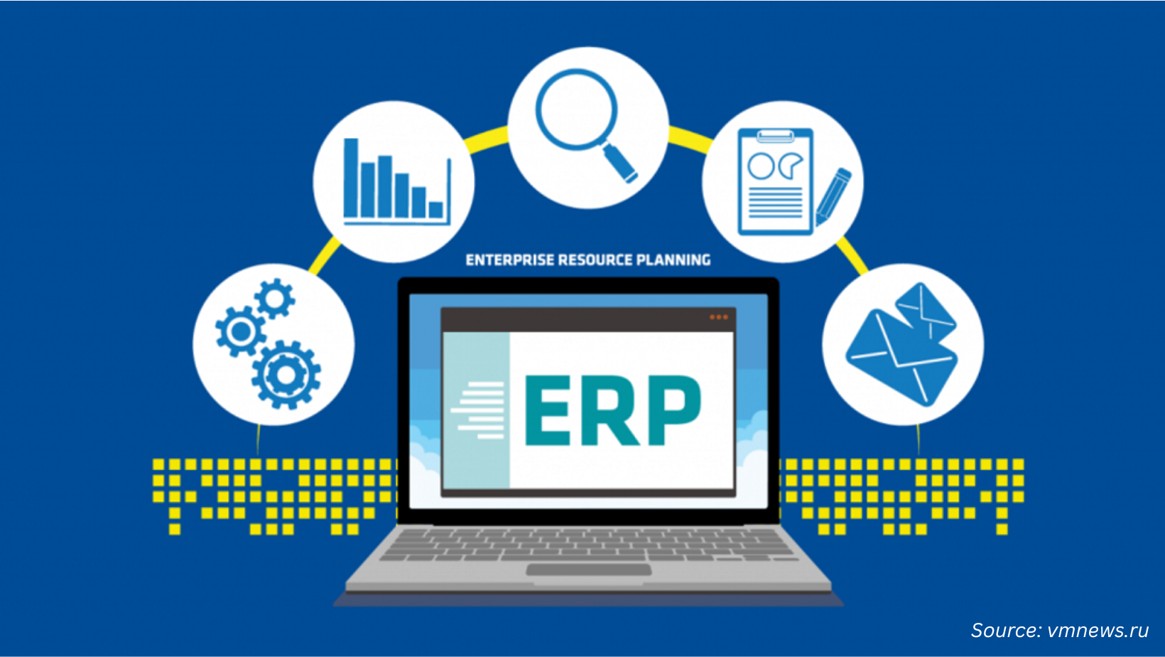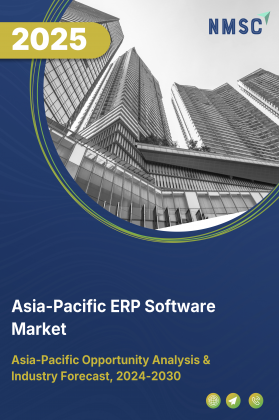
Asia-Pacific ERP Software Market by Component (Software, and Services), Deployment (On-Premise, Cloud, and Hybrid), Business Function (Enterprise Asset Management, Financial Management, Human Capital Management, and Others), Application (Manufacturing, BFSI, Healthcare, Retail & Distribution, Government, IT & Telecom, and Others), and End Users (Small & Medium Enterprises, and Large Enterprises) – Trends and Forecast, 2025–2030.
Industry: ICT & Media | Publish Date: 16-Oct-2025 | No of Pages: N/A | No. of Tables: N/A | No. of Figures: N/A | Format: PDF | Report Code : IC3592
Industry Outlook
The Asia-Pacific ERP Software Market size was valued at USD 24.82 billion in 2024 and is projected to grow to USD 30.69 billion by 2025. Additionally, the industry is expected to continue its growth trajectory, reaching USD 65.41 billion by 2030, with a CAGR of 16.34% from 2025 to 2030.
In the ERP software market in Asia-Pacific region, government-led digital initiatives are playing a crucial role in boosting ERP adoption, with India’s nationwide ERP integration in rural cooperatives serving as a prominent example. Meanwhile, the modernization of the aerospace and defence sectors, particularly in China, is significantly driving ERP demand to manage logistics, procurement, and data analytics.
Despite these advances, ERP deployment is hindered by high implementation costs, uneven digital infrastructure, and limited availability of skilled professionals, especially among SMEs. Nonetheless, the growing integration of IoT with ERP platforms is expanding operational efficiency and offering new opportunities, particularly in manufacturing and logistics, reinforcing ERP’s role as a core component of digital transformation across APAC.
Government-led Digital Initiatives Boost the Asia-Pacific ERP Software Market Growth
In Asia-Pacific, national governments are actively driving ERP adoption through strategic investments aimed at enhancing transparency, operational efficiency, and digital governance. A notable example is India’s large-scale initiative to computerize 67,930 Primary Agricultural Cooperative Societies (PACS) through a USD 302 million investment in a unified ERP-based software platform.
Implemented via NABARD and facilitated through State Cooperative Banks (StCBs) and District Central Cooperative Banks (DCCBs), the project has already onboarded over 50,000 PACS. This effort marks a significant milestone in rural digital transformation and underscores the government's commitment to scalable digital infrastructure. As public sector success stories build confidence in ERP capabilities, private sector organizations across India and other APAC economies are increasingly following suit, accelerating the adoption and expansion of ERP software across the region.
Aerospace and Defence Modernization Propels ERP Market Expansion
The Asia-Pacific ERP software market demand is experiencing substantial growth from defence and aerospace modernization, particularly in China. In 2025, China’s defence budget rose to USD 249 billion, reflecting a 7.2% annual increase and cementing its position as the world’s second-largest defence spender. This surge in military investment highlights the country's focus on operational modernization, which requires advanced ERP systems to manage complex logistics, streamline procurement, and support real-time data analytics.
Integrated ERP platforms play a crucial role in optimizing resource management and enhancing strategic decision-making, making them indispensable to China’s rapidly evolving defence and aerospace sectors. As regional defence capabilities expand, ERP adoption in mission-critical industries continues to rise.
High Implementation Costs and Structural Barriers Restrain ERP Adoption
Despite strong growth drivers, ERP adoption across Asia-Pacific faces notable challenges. High implementation costsspanning software licensing, customization, employee training, and maintenanceremain a key deterrent, especially for small and medium-sized enterprises (SMEs).
Additionally, uneven digital infrastructure, low digital literacy, and a shortage of skilled ERP professionals hinder smooth deployment across the region. Traditional business cultures and resistance to change further slow integration, while regulatory fragmentation and localization requirements add complexity for vendors operating across diverse APAC sectors. These structural barriers continue to constrain ERP market penetration in certain economies, despite the region’s overall positive outlook.
IoT-Driven ERP Solutions Expand Operational Efficiency and Market Opportunities
The integration of Internet of Things (IoT) technology with ERP systems is becoming a key catalyst for growth, offering enhanced real-time data visibility and improved operational control. IoT-enabled ERP platforms allow businesses to efficiently track inventory, monitor equipment conditions, and anticipate maintenance needs, significantly boosting performance in industries like manufacturing and logistics.
A notable example is the March 2025 launch of Epicor Kinetic2025 by Epicor Software Corporation, a next-generation ERP solution featuring advanced IoT capabilities for real-time monitoring and predictive maintenance in manufacturing settings. This development underscores the transformative role of IoT in enhancing ERP functionalities and reflects the increasing market demand for intelligent, connected enterprise solutions.
China Holds More Than 30% of Market Share in Asia-Pacific
China commands the largest Asia-Pacific ERP software market share, fuelled by the rapid expansion of its retail and distribution sector. As the retail landscape becomes more digital and customer-centric, ERP solutions play a vital role by providing real-time analytics, automation, and inventory optimization.
A Chinese government report revealed that online retail sales in Q1 2025 reached approximately USD 499.6 billion, with physical goods sales rising 5.7% year-on-year. This growth underscores the increasing need for advanced ERP systems to manage operational complexity, streamline logistics, and deliver superior customer experiences.
India to Witness Highest CAGR of 19.56% in the Asia-Pacific
India is experiencing the highest Asia-Pacific ERP software market growth in the region, largely driven by the rapid expansion of its healthcare industry. Healthcare providers are increasingly adopting ERP software to improve operational efficiency, streamline data management, and enhance patient care.
According to the India Brand Equity Foundation (IBEF), the Indian healthcare sector is expected to reach USD 638 billion by 2025, propelled by rising healthcare spending, infrastructure development, and the adoption of digital technologies. This surge is creating a strong demand for ERP systems capable of managing complex functions such as patient records, supply chain logistics, billing, and regulatory compliance. The growing integration of ERP solutions highlights their critical role in advancing digital transformation and supporting the scalability of India’s evolving healthcare ecosystem.
Competitive Landscape
The market players operating in the Asia-Pacific ERP software industry include SAP SE, Microsoft Corporation, Oracle NetSuite, Abas Software AG, Rockwell Automation, Synergix Technologies Pte Ltd., Epicor Software Corporation, Ramco Systems, Odoo, SourcePro Infotech Pvt. Ltd., Infor, Matiyas, Lighthouse Info Systems Pvt. Ltd., Kingdee International Software Group Ltd., Workday, Inc and others.
Asia- Pacific ERP Software Market Key Segments
By Component
-
Software
-
Service
By Deployment
-
On Premise
-
Cloud
-
Hybrid
By Business Function
-
Enterprise Asset Management (EAM)
-
Record Assets (Asset Mgmt)
-
Analytics & BI
-
Disposal of Assets
-
Others
-
-
Financial Management System
-
Core Financials
-
Corporate Performance Mgmt (CPM)
-
Financial Consolidation
-
Others
-
-
Human Capital Management (HCM)
-
Talent Management
-
Administrative HR
-
Workforce Management
-
Others
-
-
Manufacturing and Operations
-
Production Planning and Scheduling Products
-
Production Ops and Control Products
-
Manufacturing Information Mgmt Products
-
Others
-
-
Supply Chain Management (SCM)
-
Inventory management
-
Warehouse management
-
Transportation management
-
Procurement
-
Contract Management
-
-
Others
By Application
-
Manufacturing
-
BFSI
-
Healthcare
-
Retail & Distribution
-
Government
-
IT & Telecom
-
Construction
-
Aerospace Defense
-
Other Industries
By End Users
-
Small and Medium-Sized Enterprise
-
Large Enterprise
By Country
-
China
-
Japan
-
India
-
South Korea
-
Australia
-
Indonesia
-
Singapore
-
Taiwan
-
Thailand
-
Rest of Asia-Pacific
Key Players
-
Microsoft Corporation
-
Abas software AG
-
Rockwell Automation
-
Synergix Technologies Pte Ltd.
-
Epicor Software Corporation
-
Ramco Systems
-
Odoo
-
SourcePro Infotech Pvt. Ltd.
-
Infor
-
Matiyas
-
Lighthouse Info Systems Pvt. Ltd.
-
Kingdee International Software Group Ltd.
-
Workday, Inc.
Report Scope and Segmentation:
|
Parameters |
Details |
|
Market Size in 2025 |
USD 30.69 billion |
|
Revenue Forecast in 2030 |
USD 65.41 billion |
|
Growth Rate |
CAGR of 16.34% from 2025 to 2030 |
|
Analysis Period |
2024–2030 |
|
Base Year Considered |
2024 |
|
Forecast Period |
2025–2030 |
|
Market Size Estimation |
Billion (USD) |
|
Growth Factors |
|
|
Countries Covered |
10 |
|
Companies Profiled |
15 |
|
Market Share |
Available for 10 companies |
|
Customization Scope |
Free customization (equivalent up to 80 working hours of analysts) after purchase. Addition or alteration to country, regional, and segment scope. |
|
Pricing and Purchase Options |
Avail customized purchase options to meet your exact research needs. |

















 Speak to Our Analyst
Speak to Our Analyst



